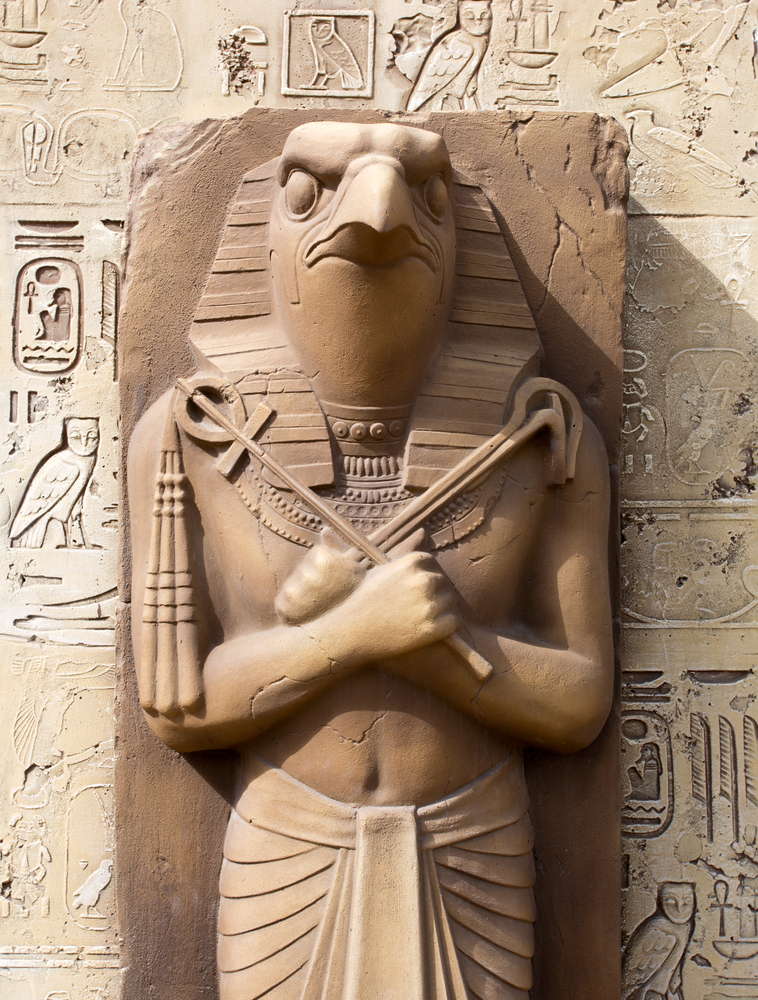Are you intrigued by the ancient myths and legends of Egypt? If so, you’ve likely encountered the enigmatic figure of Apep, also known as Apophis. This blog post delves into the fascinating stories of this serpent god, exploring the symbols and powers associated with him.
Jump to:
Who is Apep (Apophis)?
Apep, often referred to as Apophis in Greek mythology, is one of the most infamous figures in ancient Egyptian mythology. Known as the serpent of chaos, Apep embodies the forces of disorder and destruction. Unlike many Egyptian gods who were worshipped, Apep was feared and reviled. His primary role in mythology was as the eternal enemy of the sun god Ra, representing the struggle between order and chaos that is central to Egyptian cosmology.
Why Does Apep Have Two Names?
You might wonder why Apep is sometimes called Apophis. The name "Apep" is the original Egyptian name, while "Apophis" is the Greek version. The Greeks, who were fascinated by Egyptian mythology, often adapted names to fit their own language and cultural context. Regardless of the name used, both refer to the same fearsome entity.
Recommended for you!
Best SellersThe Myths and Legends of Apep

Apep’s myths and legends shed light on his fearsome nature and his role in the cosmic order:
The Eternal Battle with Ra
One of the most compelling myths about Apep is his nightly battle with Ra, the sun god. According to legend, every night, as Ra travels through the underworld in his solar barque (boat), Apep lies in wait, attempting to devour the sun and plunge the world into eternal darkness. The struggle between Ra and Apep symbolises the ongoing battle between light and darkness, order and chaos.
Apep’s Defeat and Resurrection
Despite Apep's formidable power, he is defeated every night by Ra and his allies, such as the god Seth. This cyclical battle ensures that the sun rises each morning, symbolising the triumph of order over chaos. However, Apep is not permanently destroyed and is resurrected each night to continue his attack, representing the persistent threat of chaos.
The Myth of the Solar Eclipse
Another intriguing myth involves Apep and solar eclipses. The ancient Egyptians believed that Apep’s attacks on Ra sometimes partially succeeded, resulting in solar eclipses. During an eclipse, Apep was thought to have swallowed the sun momentarily, causing darkness during daylight hours. However, Ra and his allies would ultimately overcome Apep, restoring the sun's light. This myth explained the natural phenomenon of solar eclipses while reinforcing Apep's role as a relentless adversary to Ra and the forces of order.
Apep’s Powers and Abilities

Apep possesses a range of formidable powers that make him a significant threat in Egyptian mythology. These powers underline his role as the eternal adversary of Ra and the forces of order.
- Control Over Darkness: Apep can cloak the world in darkness, symbolising his ability to disrupt the natural order and challenge the light.
- Creation of Natural Disasters: Apep's presence is believed to cause earthquakes, thunderstorms, and other natural calamities, reflecting his destructive influence on the world.
- Eclipse Generation: Apep's most dramatic power is his ability to cause solar eclipses by momentarily swallowing the sun, creating temporary periods of darkness during daylight hours.
- Immortality: Despite being defeated every night, Apep is resurrected each evening to continue his assault on Ra, symbolising the perpetual threat of chaos.
- Inducing Fear: Apep’s very existence instils fear, reinforcing his role as a symbol of ultimate evil and destruction in the Egyptian cosmos.
Apep in Rituals
Despite his fearsome nature, Apep played a role in Egyptian rituals. Priests would perform specific rites to repel Apep, ensuring the sun’s safe passage through the underworld. These rituals underscored the importance of maintaining cosmic order and the perpetual vigilance against chaos.
Apep's Symbols
Apep, as a symbol of chaos and destruction, is represented through various symbols in Egyptian mythology. These symbols highlight his fearsome nature and his opposition to order and light.
- Giant Serpent: Apep is often depicted as a colossal serpent or dragon, emphasising his menacing and powerful presence.
- Darkness: Representing chaos, Apep is associated with darkness and the underworld, where he lies in wait to attack Ra.
- Thunderstorms and Earthquakes: Apep’s influence is believed to cause natural disasters, reflecting his disruptive and destructive powers.
- Solar Eclipses: The myth of Apep swallowing the sun during an eclipse symbolises his ongoing battle with Ra and his temporary victories in the struggle between light and darkness.
- Chaos and Disorder: As the embodiment of chaos, Apep's very presence signifies the threat to Ma’at, the concept of truth, balance, and cosmic order.
Apep's Relationships and Family Tree

Unlike many deities in Egyptian mythology, Apep’s relationships and family connections are not as well-defined. His role as a symbol of chaos often places him outside the typical familial structures of other gods and goddesses.
- Solitary Figure: Apep is largely depicted as a solitary figure, representing chaos and destruction without a detailed family background. This contrasts with other gods who have complex genealogies and familial relationships.
- Enemy of Ra: The most significant relationship in Apep’s mythology is his feud with Ra, the sun god. This adversarial relationship defines much of Apep’s narrative and highlights his role as the antagonist in the cosmic order.
- Connection to Seth: In some myths, Seth, the god of storms and chaos, is seen as a defender of Ra against Apep. Despite Seth’s own chaotic nature, he stands in opposition to Apep’s threat to the sun and order, showcasing a complex dynamic between forces of chaos.
- No Known Consort: There are no myths that specifically mention Apep having a wife or consort. His role is more focused on his actions and influence rather than personal relationships.
- Symbolic Offspring: While Apep does not have direct offspring in traditional myths, his presence and actions can be seen as metaphorically giving rise to chaotic events and disasters, perpetuating his influence.
Recommended for you!
Best SellersFrequently Asked Questions about Apep
Why Was Apep Considered Evil?
In Egyptian mythology, Apep’s evil nature stems from his opposition to Ma’at, the concept of truth, balance, and cosmic order. While other deities were guardians of Ma’at, Apep sought to overthrow it, making him the embodiment of all that was chaotic and destructive. His eternal struggle against Ra further cemented his role as the antagonist in the cosmic order.
What is Apep the Egyptian God of?
Apep is not a god in the traditional sense, as he was not worshipped but feared. He is best described as a demon or a symbol of chaos and destruction. His primary role is as the adversary of Ra and the personification of chaos.
Who Killed Apep?
In various myths, Apep is defeated by different gods, but the most notable is Seth, the god of storms and chaos. Despite Seth's own chaotic nature, he stands as a protector of Ra, using his strength to fend off Apep each night.
Did Apep Have a Wife?
There are no specific myths that mention Apep having a wife. His role is largely solitary, focused on his eternal battle with Ra. This lack of familial connections further emphasises his role as a disruptive force rather than a traditional deity with familial ties.
Is Apep Still Alive?
In mythological terms, Apep is eternally alive as a symbol of chaos. His nightly defeats do not result in his permanent death, but rather his constant resurrection to challenge Ra again. This eternal cycle represents the perpetual threat of chaos to the order of the universe.
Did Apep Eat Ra?
While Apep attempts to devour Ra each night, he is ultimately unsuccessful. The mythological narrative ensures that Ra is always victorious by dawn, symbolising the triumph of light and order over darkness and chaos.
Is Apep a Demon?
Apep is often described as a demon rather than a god because he embodies evil and chaos. Unlike other gods who were worshipped and had temples, Apep was feared and represented all that was evil.
How Old is Apep?
Apep's origins in mythology date back to the early periods of ancient Egyptian civilisation. References to Apep can be found in texts from the Middle Kingdom (circa 2055–1650 BCE) and he continued to be a significant figure throughout Egyptian history.
Study Egyptian Mythology for £29
If you’re captivated by the myths and legends of ancient Egypt and want to learn more about its rich tapestry of gods and goddesses, consider enrolling in the Egyptian Mythology Diploma Course with Centre of Excellence. This fascinating course offers detailed insights into the fascinating world of Egyptian mythology, providing you with knowledge and understanding of its deities, myths, and cultural significance. For a limited time, you can enrol for a discounted price of £29.













